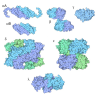+ Open data
Open data
- Basic information
Basic information
| Entry | Database: PDB / ID: 6w4p | ||||||
|---|---|---|---|---|---|---|---|
| Title | CaMKII alpha-30 Cryo-EM reconstruction - Class B | ||||||
 Components Components | (Calcium/calmodulin-dependent protein kinase type II subunit alpha) x 2 | ||||||
 Keywords Keywords | SIGNALING PROTEIN/TRANSFERASE / Calcium calmodulin dependent protein kinase II / holoenzyme / splicing / SIGNALING PROTEIN / SIGNALING PROTEIN-TRANSFERASE complex | ||||||
| Function / homology |  Function and homology information Function and homology informationpeptidyl-threonine autophosphorylation / calcium- and calmodulin-dependent protein kinase complex / regulation of endocannabinoid signaling pathway / Ca2+/calmodulin-dependent protein kinase / dendritic spine development / negative regulation of hydrolase activity / regulation of neurotransmitter secretion / Trafficking of AMPA receptors / regulation of neuron migration / positive regulation of calcium ion transport ...peptidyl-threonine autophosphorylation / calcium- and calmodulin-dependent protein kinase complex / regulation of endocannabinoid signaling pathway / Ca2+/calmodulin-dependent protein kinase / dendritic spine development / negative regulation of hydrolase activity / regulation of neurotransmitter secretion / Trafficking of AMPA receptors / regulation of neuron migration / positive regulation of calcium ion transport / calcium/calmodulin-dependent protein kinase activity / Assembly and cell surface presentation of NMDA receptors / regulation of mitochondrial membrane permeability involved in apoptotic process / CaMK IV-mediated phosphorylation of CREB / Phase 0 - rapid depolarisation / Negative regulation of NMDA receptor-mediated neuronal transmission / Unblocking of NMDA receptors, glutamate binding and activation / Ion transport by P-type ATPases / Long-term potentiation / Regulation of MECP2 expression and activity / regulation of neuronal synaptic plasticity / HSF1-dependent transactivation / glutamate receptor binding / regulation of protein localization to plasma membrane / cellular response to interferon-beta / positive regulation of cardiac muscle cell apoptotic process / Ion homeostasis / Ras activation upon Ca2+ influx through NMDA receptor / response to ischemia / angiotensin-activated signaling pathway / positive regulation of receptor signaling pathway via JAK-STAT / RAF activation / G1/S transition of mitotic cell cycle / positive regulation of NF-kappaB transcription factor activity / cellular response to type II interferon / long-term synaptic potentiation / endocytic vesicle membrane / Interferon gamma signaling / Signaling by RAF1 mutants / Signaling by moderate kinase activity BRAF mutants / Paradoxical activation of RAF signaling by kinase inactive BRAF / Signaling downstream of RAS mutants / calcium ion transport / Signaling by BRAF and RAF1 fusions / kinase activity / RAF/MAP kinase cascade / Ca2+ pathway / dendritic spine / calmodulin binding / neuron projection / protein phosphorylation / postsynaptic density / protein serine kinase activity / protein serine/threonine kinase activity / protein homodimerization activity / mitochondrion / nucleoplasm / ATP binding / metal ion binding / identical protein binding / nucleus / cytosol / cytoplasm Similarity search - Function | ||||||
| Biological species |  Homo sapiens (human) Homo sapiens (human) | ||||||
| Method | ELECTRON MICROSCOPY / single particle reconstruction / cryo EM / Resolution: 6.6 Å | ||||||
 Authors Authors | Chao, L.H. / Stratton, M.M. | ||||||
| Funding support |  United States, 1items United States, 1items
| ||||||
 Citation Citation |  Journal: Sci Signal / Year: 2020 Journal: Sci Signal / Year: 2020Title: Heterogeneity in human hippocampal CaMKII transcripts reveals allosteric hub-dependent regulation. Authors: Roman Sloutsky / Noelle Dziedzic / Matthew J Dunn / Rachel M Bates / Ana P Torres-Ocampo / Sivakumar Boopathy / Brendan Page / John G Weeks / Luke H Chao / Margaret M Stratton /  Abstract: Calcium/calmodulin-dependent protein kinase II (CaMKII) plays a central role in Ca signaling throughout the body. In the hippocampus, CaMKII is required for learning and memory. Vertebrate genomes ...Calcium/calmodulin-dependent protein kinase II (CaMKII) plays a central role in Ca signaling throughout the body. In the hippocampus, CaMKII is required for learning and memory. Vertebrate genomes encode four CaMKII homologs: CaMKIIα, CaMKIIβ, CaMKIIγ, and CaMKIIδ. All CaMKIIs consist of a kinase domain, a regulatory segment, a variable linker region, and a hub domain, which is responsible for oligomerization. The four proteins differ primarily in linker length and composition because of extensive alternative splicing. Here, we report the heterogeneity of CaMKII transcripts in three complex samples of human hippocampus using deep sequencing. We showed that hippocampal cells contain a diverse collection of over 70 CaMKII transcripts from all four CaMKII-encoding genes. We characterized the Ca/CaM sensitivity of hippocampal CaMKII variants spanning a broad range of linker lengths and compositions. The effect of the variable linker on Ca/CaM sensitivity depended on the kinase and hub domains. Moreover, we revealed a previously uncharacterized role for the hub domain as an allosteric regulator of kinase activity, which may provide a pharmacological target for modulating CaMKII activity. Using small-angle x-ray scattering and single-particle cryo-electron microscopy (cryo-EM), we present evidence for extensive interactions between the kinase and the hub domains, even in the presence of a 30-residue linker. Together, these data suggest that Ca/CaM sensitivity in CaMKII is homolog dependent and includes substantial contributions from the hub domain. Our sequencing approach, combined with biochemistry, provides insights into understanding the complex pool of endogenous CaMKII splice variants. | ||||||
| History |
|
- Structure visualization
Structure visualization
| Movie |
 Movie viewer Movie viewer |
|---|---|
| Structure viewer | Molecule:  Molmil Molmil Jmol/JSmol Jmol/JSmol |
- Downloads & links
Downloads & links
- Download
Download
| PDBx/mmCIF format |  6w4p.cif.gz 6w4p.cif.gz | 800.6 KB | Display |  PDBx/mmCIF format PDBx/mmCIF format |
|---|---|---|---|---|
| PDB format |  pdb6w4p.ent.gz pdb6w4p.ent.gz | 637.6 KB | Display |  PDB format PDB format |
| PDBx/mmJSON format |  6w4p.json.gz 6w4p.json.gz | Tree view |  PDBx/mmJSON format PDBx/mmJSON format | |
| Others |  Other downloads Other downloads |
-Validation report
| Summary document |  6w4p_validation.pdf.gz 6w4p_validation.pdf.gz | 1.4 MB | Display |  wwPDB validaton report wwPDB validaton report |
|---|---|---|---|---|
| Full document |  6w4p_full_validation.pdf.gz 6w4p_full_validation.pdf.gz | 1.5 MB | Display | |
| Data in XML |  6w4p_validation.xml.gz 6w4p_validation.xml.gz | 64.7 KB | Display | |
| Data in CIF |  6w4p_validation.cif.gz 6w4p_validation.cif.gz | 98.9 KB | Display | |
| Arichive directory |  https://data.pdbj.org/pub/pdb/validation_reports/w4/6w4p https://data.pdbj.org/pub/pdb/validation_reports/w4/6w4p ftp://data.pdbj.org/pub/pdb/validation_reports/w4/6w4p ftp://data.pdbj.org/pub/pdb/validation_reports/w4/6w4p | HTTPS FTP |
-Related structure data
| Related structure data |  21536MC  6w4oC M: map data used to model this data C: citing same article ( |
|---|---|
| Similar structure data |
- Links
Links
- Assembly
Assembly
| Deposited unit | 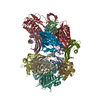
|
|---|---|
| 1 |
|
- Components
Components
| #1: Protein | Mass: 53633.953 Da / Num. of mol.: 12 Source method: isolated from a genetically manipulated source Source: (gene. exp.)  Homo sapiens (human) / Gene: CAMK2A, CAMKA, KIAA0968 / Production host: Homo sapiens (human) / Gene: CAMK2A, CAMKA, KIAA0968 / Production host:  References: UniProt: Q9UQM7, Ca2+/calmodulin-dependent protein kinase #2: Protein | | Mass: 53634.984 Da / Num. of mol.: 1 Source method: isolated from a genetically manipulated source Source: (gene. exp.)  Homo sapiens (human) / Gene: CAMK2A, CAMKA, KIAA0968 / Production host: Homo sapiens (human) / Gene: CAMK2A, CAMKA, KIAA0968 / Production host:  References: UniProt: Q9UQM7, Ca2+/calmodulin-dependent protein kinase |
|---|
-Experimental details
-Experiment
| Experiment | Method: ELECTRON MICROSCOPY |
|---|---|
| EM experiment | Aggregation state: PARTICLE / 3D reconstruction method: single particle reconstruction |
- Sample preparation
Sample preparation
| Component | Name: CaMKII alpha-30 / Type: COMPLEX / Entity ID: all / Source: RECOMBINANT |
|---|---|
| Source (natural) | Organism:  Homo sapiens (human) Homo sapiens (human) |
| Source (recombinant) | Organism:  |
| Buffer solution | pH: 8 |
| Specimen | Embedding applied: NO / Shadowing applied: NO / Staining applied: NO / Vitrification applied: YES |
| Specimen support | Details: 30 s using PELCO easiGlow / Grid material: GOLD / Grid mesh size: 300 divisions/in. / Grid type: C-flat-1.2/1.3 |
| Vitrification | Instrument: GATAN CRYOPLUNGE 3 / Cryogen name: ETHANE / Humidity: 96 % |
- Electron microscopy imaging
Electron microscopy imaging
| Experimental equipment |  Model: Talos Arctica / Image courtesy: FEI Company |
|---|---|
| Microscopy | Model: FEI TALOS ARCTICA |
| Electron gun | Electron source:  FIELD EMISSION GUN / Accelerating voltage: 200 kV / Illumination mode: FLOOD BEAM FIELD EMISSION GUN / Accelerating voltage: 200 kV / Illumination mode: FLOOD BEAM |
| Electron lens | Mode: OTHER |
| Specimen holder | Cryogen: NITROGEN |
| Image recording | Electron dose: 52 e/Å2 / Detector mode: SUPER-RESOLUTION / Film or detector model: GATAN K2 SUMMIT (4k x 4k) |
- Processing
Processing
| EM software |
| |||||||||||||||||||||||||||
|---|---|---|---|---|---|---|---|---|---|---|---|---|---|---|---|---|---|---|---|---|---|---|---|---|---|---|---|---|
| CTF correction | Type: PHASE FLIPPING AND AMPLITUDE CORRECTION | |||||||||||||||||||||||||||
| 3D reconstruction | Resolution: 6.6 Å / Resolution method: FSC 0.143 CUT-OFF / Num. of particles: 40329 / Symmetry type: POINT | |||||||||||||||||||||||||||
| Atomic model building | Protocol: RIGID BODY FIT | |||||||||||||||||||||||||||
| Atomic model building |
|
 Movie
Movie Controller
Controller






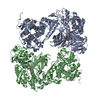
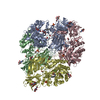
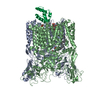
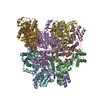
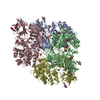
 PDBj
PDBj










